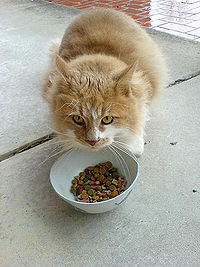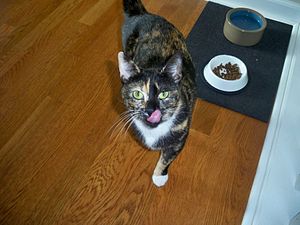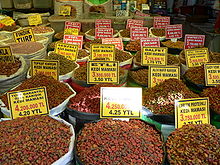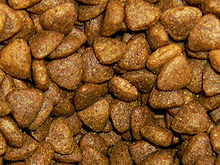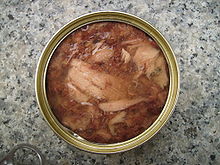- Cat food
-
Cat food is food intended for consumption by cats.
As with all species, cats have requirements for specific dietary nutrients, rather than ingredients.[1] Certain nutrients, including many vitamins and amino acids, are degraded by the temperatures, pressures and chemical treatments used during manufacture, and hence must be added after manufacture to avoid nutritional deficiency.[2][3] The amino acid taurine, for example, which is found within meat, is degraded during processing, so synthetic taurine is normally added afterwards. Long-term taurine deficiency resulting, for example, from feeding taurine-deficient dog food, may result in retinal degeneration, loss of vision, and cardiac damage.
Contents
History
The idea of preparing specialized food for cats came later than for dogs (see dog biscuits and dog food). This was very probably due to the idea that cats could readily fend for themselves. In 1837, a French writer critiqued this idea:
It is... thought wrongly that the cat, ill-fed, hunts better and takes more mice; this too is a grave error. The cat who is not given food is feeble and malingering; as soon as he has bitten into a mouse, he lies down to rest and sleep; while well fed, he is wide awake and satisfies his natural taste in chasing all that belongs to the rat family.[4]In 1844, another French writer expanded on this idea:
Normally in the country no care is taken of a cat's food, and he is left to live, it is said, from his hunting, but when he is hungry, he hunts the pantry's provisions far more than the mouse; because he does not pursue them and never watches them by need, but by instinct and attraction. And so, to neglect feeding a cat, is to render him at the same time useless and harmful, while with a few scraps regularly and properly given, the cat will never do any damage, and will render much service.[5]He goes on to say that it is all the more unreasonable to expect a cat to live from hunting in that cats take mice more for amusement than to eat: "A good cat takes many and eats few".
By 1876, Gordon Stables emphasized the need to give cats particular food:
If then, only for the sake of making (a cat) more valuable as a vermin-killer, she ought to have regular and sufficient food. A cat ought to be fed at least twice a day. Let her have a dish to herself, put down to her, and removed when the meal is finished. Experience is the best teacher as regards the quantity of a cat's food, and in quality let it be varied. Oatmeal porridge and milk, or white bread steeped in warm milk, to which a little sugar has been added, are both excellent breakfasts for puss; and for dinner she must have an allowance of flesh. Boiled lights are better for her than horse-meat, and occasionally let her have fish. Teach your cat to wait patiently till she is served—a spoiled cat is nearly as disagreeable as a spoiled child. If you want to have your cat nice and clean, treat her now and then to a square inch of fresh butter. It not only acts as a gentle laxative, but, the grease, combining in her mouth, with the alkalinity of her saliva, forms a kind of natural cat-soap, and you will see she will immediately commence washing herself, and become beautifully clean. (N.B.—If you wish to have a cat nicely done up for showing, touch her all over with a sponge dipped in fresh cream, when she licks herself the effect is wonderful.) Remember that too much flesh-meat, especially liver,—which ought only to be given occasionally,—is very apt to induce a troublesome diarrhoea (looseness). Do not give your pet too many tit-bits at table; but whatever else you give her, never neglect to let her have her two regular meals.[6]In the same year, an ad for Spratt (better known for making dog food) said that their cat food entirely superseded "the unwholesome practice of feeding on boiled horse flesh; keeps the cat in perfect health."[7] And in another book on cats Stables recommended the company's food:
Attend to the feeding, and, at a more than one-day show, cats ought to have water as well as milk. I think boiled lights, cut into small pieces, with a very small portion of bullock's liver and bread soaked, is the best food; but I have tried Spratt's Patent Cat Food with a great number of cats, both of my own and those of friends, and have nearly always found it agree; and at a cat show it would, I believe, be both handy and cleanly.[8]Spratt, which began by making dog biscuits, appears to also have been the first commercial producer of cat food.
Commercial cat food
Most store-bought cat food comes in either dry form, also known in the US as kibble, or wet canned form. Some manufacturers sell frozen raw diets and premix products to cater to owners who feed raw.
Dry food
Dry food (8-10% moisture) is generally made by extrusion cooking under high heat and pressure. Fat may then be sprayed on the food to increase palatability, and other minor ingredients, such as heat-sensitive vitamins, which would be destroyed in the extrusion process, may be added.
Wet food
Canned or wet food (75-78% moisture) generally comes in common can sizes of 3 oz (85 g), 5.5 oz (156 g), and 13 oz (369 g). It is also sold in foil pouch form by some manufacturers.
Dry Food vs Wet food
There is debate as to what is best, wet food or dry food. A good quality either wet or dry can be more than satisfactory for a cat's nutritional requirements. Wet food has more moisture than dry food, making water intake especially important for cats who eat primarily dry food.
Vegetarian or vegan food
There are vegetarian and vegan cat foods available. Vegetarian cat food usually is fortified with nutrients such as taurine and arachidonic acid.[9] Some vegetarian cat food brands are labeled by their manufacturers as meeting AAFCO's Cat Food Nutrient Profile.[citation needed]
Labeling
In the United States, cat foods labeled as "complete and balanced" must meet standards established by the Association of American Feed Control Officials (AAFCO) either by meeting a nutrient profile or by passing a feeding trial. Cat Food Nutrient Profiles were established in 1992 and updated in 1995 by the AAFCO's Feline Nutrition Expert Subcommittee. The updated profiles replaced the previous recommendations set by the National Research Council(NRC). Certain manufacturers label their products with terms such as premium, ultra premium, natural and holistic. Such terms currently have no legal definitions.[citation needed]
Energy requirement
The energy requirement for adult cats range from 60–70 kcal metabolizable energy/kg body weight per day for inactive cats to 80–90 kcal/kg BW for active cats. Kittens at five weeks of age require 250 kcal/kg BW. The requirement drops with age, to 100 kcal/kg BW at 30 weeks and to the adult requirement at about 50 weeks. Gestating cats require about 90–100 kcal/kg BW and lactating cats 90–270 kcal/kg BW depending on litter size.[10]
Nutrients and functions
Vitamin deficiencies can lead to wide ranging clinical abnormalities that reflect the diversity of their metabolic roles. Twelve minerals are known to be essential nutrients for cats. Calcium and phosphorus are crucial to strong bones and teeth. Cats need other minerals, such as magnesium, potassium, and sodium, for nerve impulse transmission, muscle contraction, and cell signaling. Many minerals only present in minute amounts in the body, including selenium, copper, and molybdenum, act as helpers in a wide variety of enzymatic reactions.[11]
The table below lists the AAFCO nutritional profiles for cat foods along with the roles of vitamins and minerals in cat nutrition according to the National Research Council.
Diet and disease
Vegan and vegetarian diets
The feeding of vegan or vegetarian diets to cats remains controversial, even among vegan, vegetarian, animal, and scientific advocacy groups. According to the National Research Council, "Cats require specific nutrients, not specific feedstuffs.".[9] The International Vegetarian Union,[12] the Vegan Society[13] and PETA[14] [15] are some of the organizations that support a vegan or vegetarian diet for cats. The Animal Protection Institute does not recommend a vegetarian diet for cats,[16] and neither does the American Society for the Prevention of Cruelty to Animals (ASPCA).[17]
Not all animal advocacy groups take a firm position either way. The Association of Veterinarians for Animal Rights (now Humane Society Veterinary Medical Association) accepts that it is possible for a plant based diet to be nutritionally adequate but stated that they "cannot at this time be reliably assured".[18] This position was based on a study demonstrating that two commercially available vegetarian cat diets contained nutritional deficiencies.[19] However, broad conclusions cannot be drawn from this study, because (i) it examined only two of many available diets, (ii) for one of these diets, the formulation error responsible was promptly identified and corrected,[20] and (iii) this 2004 study is increasingly dated. Nevertheless, it remains likely that formulation errors will result in nutritional deficiencies in a wide range of commercially available diets from time to time, whether meat-based, vegetarian or vegan. Hence, regular (at least, annual) veterinary checkups of all companion animals is recommended, and brands may be occasionally varied.[20]
Vegan activist Joanne Stepaniak wrote "... If we [believe] that it is wrong for natural vegetarians to be force-fed meat, the inverse should be equally morally objectionable".[21]
In 2006 the first study of the health of a population of long-term vegetarian cats (most, in fact, were vegan), was published in the Journal of the American Veterinary Medical Association.[22] Most were clinically healthy, barring minor blood value changes in three cats, who were fed partly on table scraps.[citation needed]
Homemade food
Many pet owners feed cats homemade diets. These diets generally consist of some form of cooked or raw meat, bone, vegetables, and supplements, such as taurine and multivitamins.[citation needed]
Bisphenol A
A 2004 study reported that food packaged in cans coated with bisphenol A is correlated with the development of hyperthyroidism in cats.[23]
Food allergy
Food allergy is a non-seasonal disease with skin and/or gastrointestinal disorders. The main complaint is excessive scratching (Pruritus) which is usually resistant to treatment by steroidal anti-inflammatory drugs. The exact prevalence of food allergy in cats remains unknown. In 20 to 30% of the cases, cats have concurrent allergic diseases (atopy / flea-allergic dermatitis). A reliable diagnosis can only be made with dietary elimination-challenge trials. Allergy testing is necessary for the identification of the causative food component(s). Therapy consists of avoiding the offending food component(s).[24]
Malnutrition
Malnutrition can be a problem for cats fed non-conventional diets. Cats fed exclusively on raw, freshwater fish can develop a thiamine deficiency. Those fed exclusively on liver may develop vitamin A toxicity. Also, exclusively meat-based diets may contain excessive protein and phosphorus whilst being deficient in calcium, vitamin E, and microminerals such as copper, zinc, and potassium. Energy density must also be maintained relative to the other nutrients. When vegetable oil is used to maintain the energy balance cats may not find the food as palatable.[25]
Recalls
The broad pet food recalls starting in March 2007 came in response to reports of renal failure in pets consuming mostly wet pet foods made with wheat gluten from a single Chinese company beginning in February 2007. Overall, several major companies recalled more than 100 brands of pet foods with most of the recalled product coming from Menu Foods. The most likely cause according to the FDA is the presence of melamine in the wheat gluten of the affected foods. Melamine is known to falsely inflate the protein content rating of substances in laboratory tests. The economic impact on the pet food market has been extensive, with Menu Foods losing roughly $30 Million alone from the recall.
Nutrient chart
Association of American Feed Control Officials (AAFCO) Cat Food Nutrient Profiles a [26]
with Role of Vitamins & Minerals [11]Nutrient Units
(Dry Matter Basis)Growth and
reproduction
minimumAdult
maintenance
minimumMaximum Functions Signs of deficiency/Excess Protein % 30.0 26.0 Arginine % 1.25 1.04 Histidine % 0.31 0.31 Isoleucine % 0.52 0.52 Leucine % 1.25 1.25 Lysine % 1.20 0.83 Methionine + cystine % 1.10 1.10 Methionine % 0.62 0.62 1.50 Phenylalanine + tyrosine % 0.88 0.88 Phenylalanine % 0.42 0.42 Threonine % 0.73 0.73 Tryptophan % 0.25 0.16 Valine % 0.62 0.62 Fatb % 9.0 9.0 Linoleic acid % 0.5 0.5 Arachidonic acid % 0.02 0.02 Minerals Calcium % 1.0 0.6 - Formation of bones and teeth
- Blood coagulation
- Nerve impulse transmission
- Muscle contraction
- Cell signaling
- Deficiency
- Nutritional secondary hyperparathyroidism
- loss of bone mineral content, which can lead to collapse and curvature of lumbar vertebrae and pelvic bones
- bone pain, which can progress to pathological fractures
- Excess
- Depressed food intake
- Decreased growth
- Increased bone mineral density
- Increased need for magnesium
Phosphorus % 0.8 0.5 - Skeletal structure
- DNA and RNA structure
- Energy metabolism
- Locomotion
- Acid-base balance
- Deficiency
- Hemolytic anemia
- Locomotor disturbances
- Metabolic acidosis
Potassium % 0.6 0.6 - Acid-base balance
- Nerve-impulse transmission
- Enzymatic reactions
- Transport functions
- Deficiency
- Anorexia
- Retarded growth
- Neurological disorders, including ataxia and severe muscle weakness
Sodium % 0.2 0.2 - Acid-base balance
- Regulation of osmotic pressure
- Nerve impulse generation and transmission
- Deficiency
- Anorexia
- Impaired growth
- Excessive thirst and drinking
- Excessive urination
Chlorine / Chloride % 0.3 0.3 - Acid-base balance
- Osmolarity of extracellular fluids
- Deficiency
- Increased sodium concentration in renal fluid
- Excess potassium excretion
Magnesium c % 0.08 0.04 - Enzyme functions
- Muscle and nerve-cell membrane stability
- Hormone secretion and function
- Mineral structure of bones and teeth
- Deficiency
- Poor growth
- Overextension of the carpal joints
- Muscle twitching
- Convulsions
- Excess
- Urinary tract stone formation in the presence of high pH
Iron d mg/kg 80.0 80.0 - Hemoglobin and myoglobin synthesis
- Energy metabolism
- Deficiency
- Poor growth
- Pale mucous membranes
- Lethargy
- Weakness
- Diarrhea
- Excess
- Vomiting and diarrhea
Copper (extruded food) e mg/kg 15.0 5.0 - Connective tissue formation
- Iron metabolism
- Blood cell formation
- Melanin pigment formation
- Myelin formation
- Defense against oxidative damage
- Deficiency
- Reduced weight gain
- Longer time to conceive
Copper (canned food) e mg/kg 5.0 5.0 Manganese mg/kg 7.5 7.5 - Enzyme functions
- Bone development
- Neurological function
No studies of deficiency in cats
Zinc mg/kg 75.0 75.0 2000.0 - Enzyme reactions
- Cell replication
- Protein and carbohydrate metabolism
- Skin function
- Wound healing
- Deficiency
- Skin lesions
- Growth retardation
- Testicular damage
Iodine mg/kg 0.35 0.35 - Thyroid hormone synthesis
- Cell differentiation
- Growth and development of puppies
- Regulation of metabolic rate
- Deficiency
- Enlargement of thyroid glands
- Excess
- Excessive tearing, salivation, and nasal discharge
- Dandruff
Selenium mg/kg 0.1 0.1 - Defense against oxidative damage
- Immune response
No studies of deficiency in cats
Vitamins Vitamin A IU/kg 9000.0 5000.0 750000.0 - Vision
- Growth
- Immune function
- Fetal development
- Cellular differentiation
- Transmembrane protein transfer
- Deficiency
- Conjunctivitis
- Cataracts, retinal degeneration, and other eye problems
- Weight loss
- Muscle weakness
- Reproductive and developmental disorders
- Excess
- Skeletal lesions in kittens, particularly outgrowths of the cervical vertebrae
- Osteoporosis
Vitamin D IU/kg 750.0 500.0 10000.0 - Maintenance of mineral status
- Skeletal structure
- Muscle contraction
- Blood clotting
- Nerve conduction
- Cell signaling
- Phosphorus balance
- Deficiency
- Rickets
- Abnormalities in skeletal development
- Progressive paralysis
- Ataxia
- Lack of grooming
- Reduction in body weight and food intake
- Excess
- Anorexia
- Vomiting
- Lethargy
- Calcification of soft tissues
Vitamin E f IU/kg 30.0 30.0 - Defense against oxidative damage via free radical scavenging
- Deficiency
- Anorexia
- Depression
- Pain sensitivity in abdomen
- Fat tissue pathology
Vitamin K g mg/kg 0.1 0.1 - Activation of clotting factors, bone proteins, and other proteins
- Deficiency
- Prolonged blood clotting times
- Hemorrhaging
Vitamin B1 / Thiamine h mg/kg 5.0 5.0 - Energy and carbohydrate metabolism
- Activation of ion channels in neural tissue
- Deficiency
- Neurological impairments including altered reflexes and convulsive seizures
- Heart-rate disorders
- Pathological changes in the central nervous system
- Severe learning deficits
Riboflavin mg/kg 4.0 4.0 - Enzyme functions
- Deficiency
- Cataracts
- Fatty livers
- Testicular atrophy
Pantothenic acid mg/kg 5.0 5.0 - Energy metabolism
- Deficiency
- Stunted growth
- Fatty changes in liver
- Small bowel lesions
Niacin mg/kg 60.0 60.0 - Enzyme functions
- Deficiency
- Anorexia
- Weight loss
- Elevated body temperature
- Fiery red tongue, with ulceration and congestion
Vitamin B6 / Pyridoxine mg/kg 4.0 4.0 - Glucose generation
- Red blood cell function
- Niacin synthesis
- Nervous system function
- Immune response
- Hormone regulation
- Gene activation
- Deficiency
- Stunted growth
- Convulsive seizures
- Kidney lesions
Folic Acid mg/kg 0.8 0.8 - Amino acid and nucleotide metabolism
- Mitochondrial protein synthesis
- Deficiency
- Decreased growth rate
- increased iron levels in blood
Biotin i mg/kg 0.07 0.07 Vitamin B12 mg/kg 0.02 0.02 - Enzyme functions
- Deficiency
- Weight loss
- Vomiting
- Diarrhea
- Intestinal disorders
Cholinej mg/kg 2400.0 2400.0 Taurine (extruded food) % 0.10 0.10 Taurine (canned food) % 0.20 0.20 Nutrient Units
(Dry Matter Basis)Growth and
Reproduction
MinimumAdult
Maintenance
MinimumMaximum Functions Signs of Deficiency/Excess NOTES- Presumes an energy density of 4.0 kcal/g ME, based on the modified Atwater values of 3.5, 8.5, and 3.5 kcal/g for protein, fat, and carbohydrate (nitrogen-free extract, NFE), respectively. Rations greater than 4.5 kcal/g should be corrected for energy density; rations less than 4.0 kcal/g should not be corrected for energy.
- Although a true requirement for fat per se has not been established, the minimum level was based on recognition of fat as a source of essential fatty acids, as a carrier of fat-soluble vitamins, to enhance palatability, and to supply an adequate caloric density.
- If the mean urine pH of cats fed ad libitum is not below 6.4, the risk of struvite urolithiasis increases as the magnesium content of the diet increases.
- Because of very poor bioavailability, iron from carbonate or oxide sources that are added to the diet should not be considered as components in meeting the minimum nutrient level.
- Because of very poor bioavailability, copper from oxide sources that are added to the diet should not be considered as components in meeting the minimum nutrient level.
- Add 10 IU vitamin E above minimum level per gram of fish oil per kilogram of diet.
- Vitamin K does not need to be added unless diet contains greater than 25 percent fish on a dry matter basis.
- Because processing may destroy up to 90 percent of the thiamine in the diet, allowance in formulation should be made to ensure the minimum nutrient level is met after processing.
- Biotin does not need to be added unless diet contains antimicrobial or antivitamin compounds.
- Methionine may substitute choline as methyl donor at a rate of 3.75 parts for 1 part choline by weight when methionine exceeds 0.62 percent.
See also
- Cat food brands
References
- ^ Knight, A (2005). "In defense of vegetarian cat food". J. Am. Vet. Med. Assoc. 226 (4): 512–3. doi:10.2460/javma.2005.226.512. PMID 15742685.
- ^ Howell E. Food Enzymes for Health & Longevity Woodstock Valley, CT, US: Omangod Press. xx. 1980.
- ^ [1] | Perry T. What's really for dinner? The truth about commercial pet food. The Animals' Agenda. 1996. Nov. - Dec.
- ^ Mauny de Mornay, Livre de l'eleveur et du proprietaire d'animaux domestiques 1837 http://books.google.com/books?printsec=frontcover&dq=intitle:%22animaux+domestiques%22&lr=&as_drrb_is=b&as_minm_is=0&as_miny_is=1800&as_maxm_is=0&as_maxy_is=1880&cd=36&pg=PA287&id=tBkGwxXqxpgC&num=100&as_brr=1#v=onepage&q&f=false
- ^ Nicolas Jean Baptiste Boyard, Manuel du bouvier et zoophile: ou l'art d'élever de soigner les animaux 1844 http://books.google.com/books?pg=RA2-PA328&dq=intitle:%22animaux+domestiques%22+chat&lr=&as_drrb_is=b&as_minm_is=0&as_miny_is=1800&as_maxm_is=0&as_maxy_is=1880&cd=49&id=ODpFAAAAYAAJ&num=100&as_brr=1#v=onepage&q=intitle%3A%22animaux%20domestiques%22%20chat&f=false
- ^ Gordon Stables, 'Cats': their points and characteristics, with Curiosities of cat life, and ... 1876 http://books.google.com/books?pg=PA371&dq=cat+food+%22cat+food%22&lr=&as_drrb_is=b&as_minm_is=0&as_miny_is=1850&as_maxm_is=0&as_maxy_is=1880&cd=11&id=iUUDAAAAQAAJ&num=100&as_brr=0#v=onepage&q=cat%20food%20%22cat%20food%22&f=false
- ^ ad for Spratt's http://books.google.com/books?id=5-ANAAAAQAAJ&pg=PP8&dq=cat+food+%22cat+food%22&lr=&as_drrb_is=b&as_minm_is=0&as_miny_is=1850&as_maxm_is=0&as_maxy_is=1880&num=100&as_brr=0&cd=26#v=onepage&q=cat%20food%20%22cat%20food%22&f=false
- ^ Gordon Stable, The domestic cat, 1876, 61 http://books.google.com/books?printsec=frontcover&dq=%22+%22+intitle:cat&lr=&as_drrb_is=b&as_minm_is=0&as_miny_is=1850&as_maxm_is=0&as_maxy_is=1880&cd=10&pg=PA61&id=30oDAAAAQAAJ&num=100&as_brr=1#v=onepage&q&f=false
- ^ a b Nutrient Requirements of Cats. National Academies Press. Pg 30. ISBN 9780309036825
- ^ Subcommittee on Cat Nutrition, Committee on Animal Nutrition, Board on Agriculture, National Research Council. (1986). Nutrient requirements of cats. Washington, D.C: National Academy Press. pp. 4–5. ISBN 0-309-03682-8. http://books.google.com/?id=UTArAAAAYAAJ.
- ^ a b Subcommittee on Dog and Cat Nutrition (Committee on Animal Nutrition, Board on Agriculture and Natural Resources, Division on Earth and Life Studies) (2006). "The Role of Vitamins and Minerals in the Diet for Cats". Nutrient Requirements of Cats and Dogs. ISBN 0309086280. National Research Council - National Academies. http://www.nap.edu/catalog.php?record_id=10668. Retrieved 2007-03-08.
- ^ FAQ. The International Vegetarian Union.
- ^ [2] Vegan Society.
- ^ [3] The Cat Guide.
- ^ Meatless Meals for Dogs and Cats. PETA.
- ^ Selecting a Commercial Pet Food. Born Free/Animal Protection Institute.
- ^ Nutrition Q & A: Vegetarian Diets for Dogs. ASPCA.
- ^ "AVAR position statements: Vegan and Vegetarian Cat and Dog Food Diets" Association of Veterinarians for Animal Rights
- ^ Gray, CM; Sellon, RK, Freeman LM (2004). "Nutritional adequacy of two vegan diets for cats". Journal of the American Veterinary Medical Association, JAVMA (American Veterinary Medical Association, AVMA) 225 (11): 1670–5.
- ^ a b Knight, A (2005). "In defense of vegetarian cat food". Journal of the American Veterinary Medical Association, JAVMA (American Veterinary Medical Association, AVMA) 226 (4): 512–3.
- ^ Being Vegan Joanne Stepaniak.
- ^ Wakefield, LA; Shofer, FS & Michel, KE (2006). "Evaluation of cats fed vegetarian diets and attitudes of their caregivers". Journal of the American Veterinary Medical Association, JAVMA (American Veterinary Medical Association, AVMA) 229 (1): 70–3.
- ^ Edinboro, Charlotte H.; Scott-Moncrieff, Catharine; Janovitz, Evan; Thacker, Leon ; Glickman, Larry T. (March 2004). "Epidemiologic study of relationships between consumption of commercial canned food and risk of hyperthyroidism in cats". Journal of the American Veterinary Medical Association, JAVMA (American Veterinary Medical Association, AVMA) 224 (6): 879–86. doi:10.2460/javma.2004.224.879. http://avmajournals.avma.org/doi/abs/10.2460/javma.2004.224.879. Retrieved 2008-03-10.
- ^ Verlinden A, Hesta M, Millet S, Janssens GP (2006). "Food allergy in dogs and cats: a review". Crit Rev Food Sci Nutr 46 (3): 259–73. doi:10.1080/10408390591001117. PMID 16527756.
- ^ John E. Bauer, D.V.M., Ph.D., Dipl. A.C.V.N. (2005-01-01). "Nutritional Requirements and Related Diseases". The Merck Veterinary Manual, 9th edition. ISBN 0-911910-50-6. Merck & Co., Inc.. http://www.merckvetmanual.com/mvm/index.jsp?cfile=htm/bc/182902.htm. Retrieved 2006-10-27.
- ^ David A. Dzanis, D.V.M., Ph.D., DACVN Division of Animal Feeds, Center for Veterinary Medicine (November 1997). "SELECTING NUTRITIOUS PET FOODS". INFORMATION FOR CONSUMERS. Food and Drug Administration - Center for Veterinary Medicine. http://www.fda.gov/cvm/petfood.htm. Retrieved 2005-01-20.[dead link]
Further Information
- From the U.S. Food and Drug Administration - Center For Veterinary Medicine
- Pet Foods
- Information For Consumers - FDA's Regulation Of Pet Food
- Information For Consumers - Information On Marketing A Pet Food Product
- Information For Consumers - Interpreting Pet Food Labels
- Information For Consumers - Interpreting Pet Food Labels - Special Use Foods
- Vegetarian Diets For Pets?
- Report on the risk from pentobarbital in dog food
- The Vegetarian Society UK on concerns relating to a vegetarian diet for cats
- The Cat That Ate Tofu Alternet article on vegan cat food
- Vegan Pet Food: A Discussion Animal Voices audio interview with Evolution pet food CEO
- From Max's House Feline Medical And Behavior Database
- Buffington CA (June 2008). "Dry foods and risk of disease in cats". Can. Vet. J. 49 (6): 561–3. PMC 2387258. PMID 18624064. http://www.pubmedcentral.nih.gov/articlerender.fcgi?tool=pmcentrez&artid=2387258. – disputes the claim that dry food is harmful
- Get The Facts - What's Really In Pet Food from Animal Protection Institute
- From AAFCO
Categories:- Cats as pets
- Pet foods
Wikimedia Foundation. 2010.

